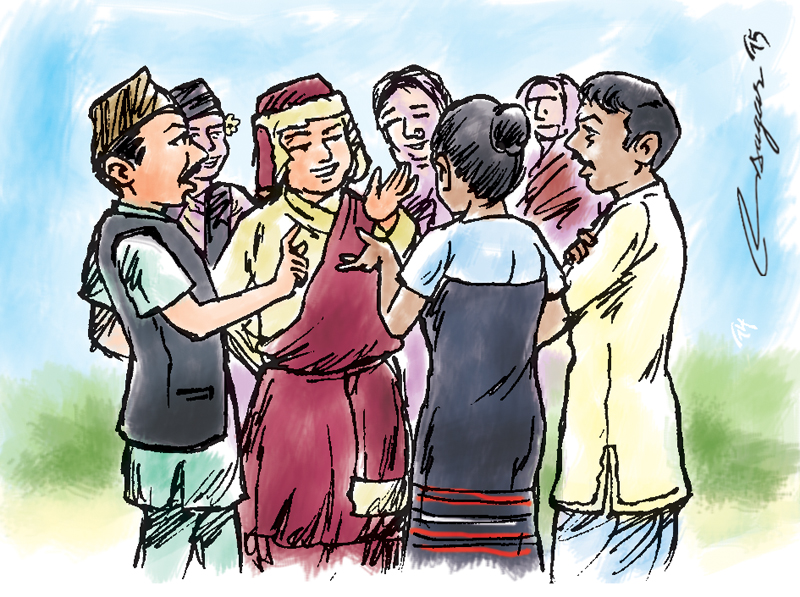Backward classes
These underdeveloped races or classes, along with women and Dalits, should be uplifted and more of them should be included in the government administration or government by making them qualified enough to be given the lucrative posts
There are backward classes of people in almost all the countries. There are also socially or economically backward classes or races in Nepal, too. But the classification made to identify them seems to be wrong, and not just in the current draft constitution. In other words, the base of choosing backward class or race is not justifiable. Such unjustifiable base to choose backward classes may give special advantages to the non backward classes instead of backward classes and backward classes may be left behind.
In this way, facilities given to the backward classes by the state for their uplift or inclusion will not reach the real backward classes. In the draft of our constitution in Article 23 (3) the distinguished group of backward classes are known as Adibasi, (indigenous); Madhesi Janajati, Tharu, Muslim, Simantakrit (marginalised), Loponmukh, female, Dalit and so on.
The classification or distinction made in this way cannot identify the real backward classes of citizens. The indigenous are also included in the backward class. But there is no definition given to the indigenous classes in the draft constitution. Adibasis (indigenous) mean primitive or original inhabitants. But which classes or races of Nepal settled first in Nepal as original inhabitants and which classes of them came to Nepal to settle later from other countries? Has anyone any data to show when the different groups or races came to Nepal to settle? Are only Madhesis indigenous inhabitants of Nepal or are there other races or classes who are the indigenous or original inhabitants of Nepal?
Using Adibasis as the base to distinguish the backward classes is not appropriate. Some say Newars are Adibasi (indigenous inhabitants), some say Tharus and some say Sherpas are the original inhabitants. If so, are other classes or races asylum seekers from other countries to Nepal? Are not Magars and Gurungs indigenous citizens? And are not Brahmins and Kshetris indigenous citizens? Are they asylum seekers from other countries who later settled down in Nepal?
Similarly, there are other categories such as "Janajati" for distinguishing the backward or underdeveloped classes in Nepal. These are Tamangs, Gurungs, Sherpas, Magars, Rais, Tharus, Chaudharis, even Newars and so on, except for Dalits, Brahmins and Kshetris. These races or classes are identified as Janajatis. This kind of distinguishing will be unable to introduce underdeveloped or backward classes. Newars, under Janajati, are not underdeveloped or backward races. There are as many educated or high ranking and socially advanced people belonging to Brahmins and Kshetris and in Newar races. There are richer people than Brahmins, Kshetris and Thakuris. We can see high ranking and socially and politically advanced persons who are Newars. There are also many judges, lawyers, and engineers, political and social leaders belonging to this class. Among the people of hill origin most trade and commerce are handled by them. So how can this class be referred to as underdeveloped or backward?
In comparison with Brahmin, Kshetri and Newar classes, Rai, Limbu, Tamang, Gurung, Tharu classes seem less developed. However, there are many educated persons, political leaders and high ranking persons even in these classes as well. Appeal court lawyers and some judges and engineers also belong to these classes, take just a few examples. As such, these races and classes also cannot be referred to as underdeveloped or backward groups.
There are many other classes or races, such as Raute, Chepang, Musahar, Kurmi and Dalit and so on, who should be taken as underdeveloped or backward classes of people of Nepal in comparison to other classes and races. Similarly, women also should be considered to belong this underdeveloped group. So while considering the socially or economically underdeveloped or backward groups or classes for lifting or inclusion it will be better to distinguish them in the name of women, Dalit and other underdeveloped classes.
These underdeveloped races or classes, along with women and Dalits, should be uplifted and more of them should be included in the government administration or government by making them qualified enough to be given the lucrative posts. The government must help these classes to make themselves qualified and competent by helping them by giving the necessary scholarships in their schools or colleges.
In government posts some fixed seats should be reserved for the backward or underdeveloped class of candidates. Besides reserved seats, some extra, say 10 or 15 candidates, also should be appointed by making it easier for them to pass the competitive examinations. Unqualified candidates should not be provided with the jobs no matter which class they belong to, underdeveloped or not, for this will spoil the whole governmental machinery. Even to be a candidate or acquire membership of the parliament or ministry of the Nepal government, the minimum educational qualification must be set. In the present age those having no general knowledge of government administration or international affairs must not be made a member of parliament or a minister or allowed to hold other such coveted high posts.
Adhikary is an advocate






